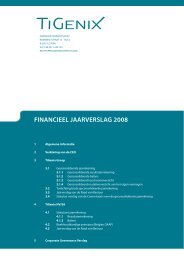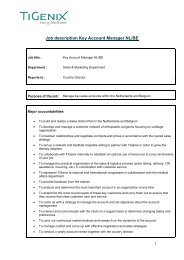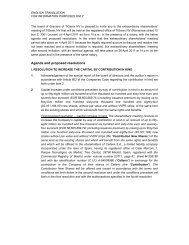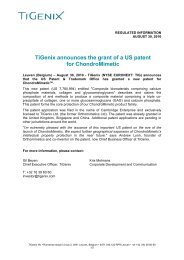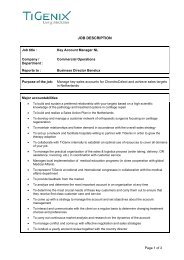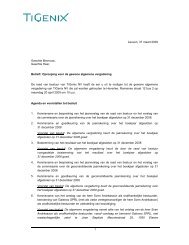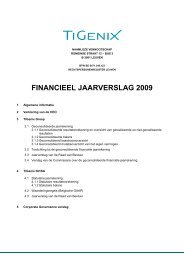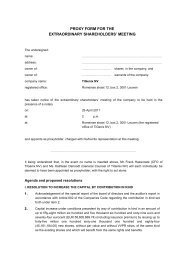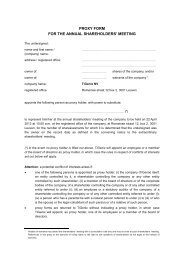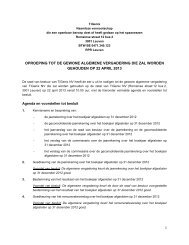ANNUAL REPORT 2012 - TiGenix
ANNUAL REPORT 2012 - TiGenix
ANNUAL REPORT 2012 - TiGenix
Create successful ePaper yourself
Turn your PDF publications into a flip-book with our unique Google optimized e-Paper software.
7.2. BOARD OF DIRECTORS<br />
7.2.1. General provisions<br />
The Board of Directors has the broadest<br />
powers to manage and represent the<br />
Company, except to the extent provided<br />
otherwise by applicable law or the Articles<br />
of Association. The Board of Directors acts<br />
as a collegiate body but can delegate<br />
its competencies for special and specific<br />
matters to an authorized representative,<br />
even if this person is not a shareholder or a<br />
director.<br />
Pursuant to the Articles of Association, the<br />
Board of Directors is to be composed of at<br />
least three (3) directors and a maximum<br />
of nine (9) members. Pursuant to the<br />
Company’s corporate governance charter,<br />
at least half of the directors must be nonexecutive<br />
directors and at least three (3) of<br />
them must be independent.<br />
may be convened to deliberate and decide<br />
on the matters on the agenda of the board<br />
meeting for which a quorum was not present.<br />
In any event, the Board of Directors may only<br />
validly proceed if at least two directors are<br />
present. Meetings of the Board of Directors<br />
are convened by the chairman of the<br />
board or by at least two directors whenever<br />
the interests of the Company so require. In<br />
principle, the board will meet at least six (6)<br />
times per year.<br />
The chairman of the Board of Directors has<br />
a casting vote on matters submitted to the<br />
Board of Directors.<br />
7.2.2. Chairman<br />
The Company’s corporate governance<br />
charter provides that the Board of Directors<br />
appoints a chairman amongst the<br />
independent directors. The CEO cannot be<br />
the chairman.<br />
The directors of the Company are appointed<br />
by the general shareholders’ meeting.<br />
However, in accordance with the Companies<br />
Code, if the mandate of a director becomes<br />
vacant due to his death or resignation, the<br />
remaining directors have the right to appoint<br />
temporarily a new director to fill the vacancy<br />
until the first general shareholders’ meeting<br />
after the mandate became vacant. The new<br />
director completes the term of the director<br />
whose mandate became vacant. The<br />
corporate governance charter provides that<br />
directors can be appointed for a maximum<br />
(renewable) term of four years.<br />
A meeting of the Board of Directors is validly<br />
constituted if there is a quorum, consisting<br />
of at least half of the members present in<br />
person or represented at the meeting. If this<br />
quorum is not present, a new board meeting<br />
The chairman of the Board of Directors is<br />
responsible for the leadership of the Board of<br />
Directors. The chairman takes the necessary<br />
measures to develop a climate of trust within<br />
the Board of Directors, contributing to open<br />
discussion, constructive dissent and support<br />
for the decisions of the Board of Directors.<br />
The chairman promotes effective interaction<br />
between the board and the executive<br />
management. The chairman establishes a<br />
close relationship with the CEO, providing<br />
support and advice, while fully respecting<br />
the executive responsibilities of the CEO.<br />
The chairman has additional specific tasks.<br />
These are further described in the terms of<br />
reference of the Board of Directors as set out<br />
in the Company’s corporate governance<br />
charter.<br />
82 <strong>TiGenix</strong> I annual report <strong>2012</strong>



